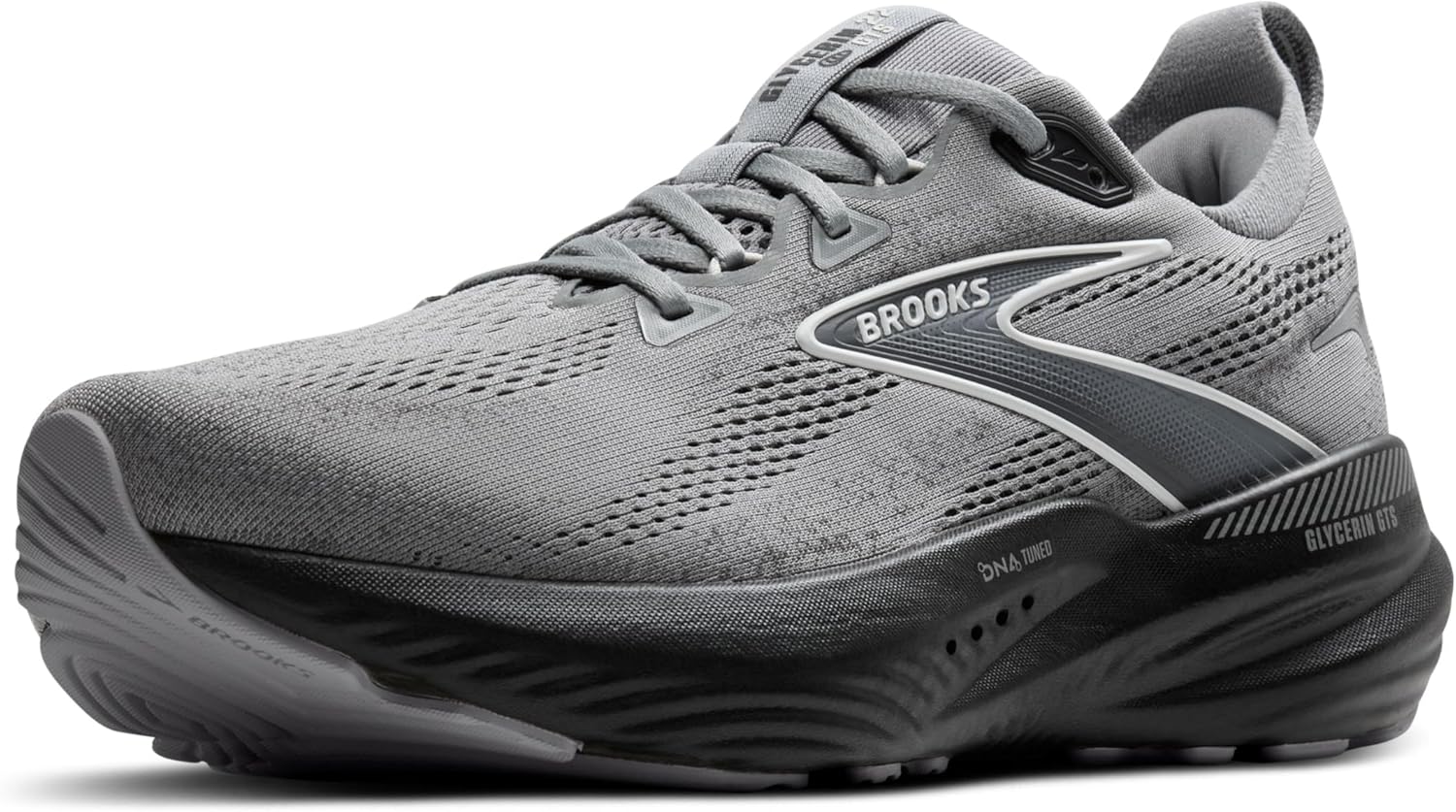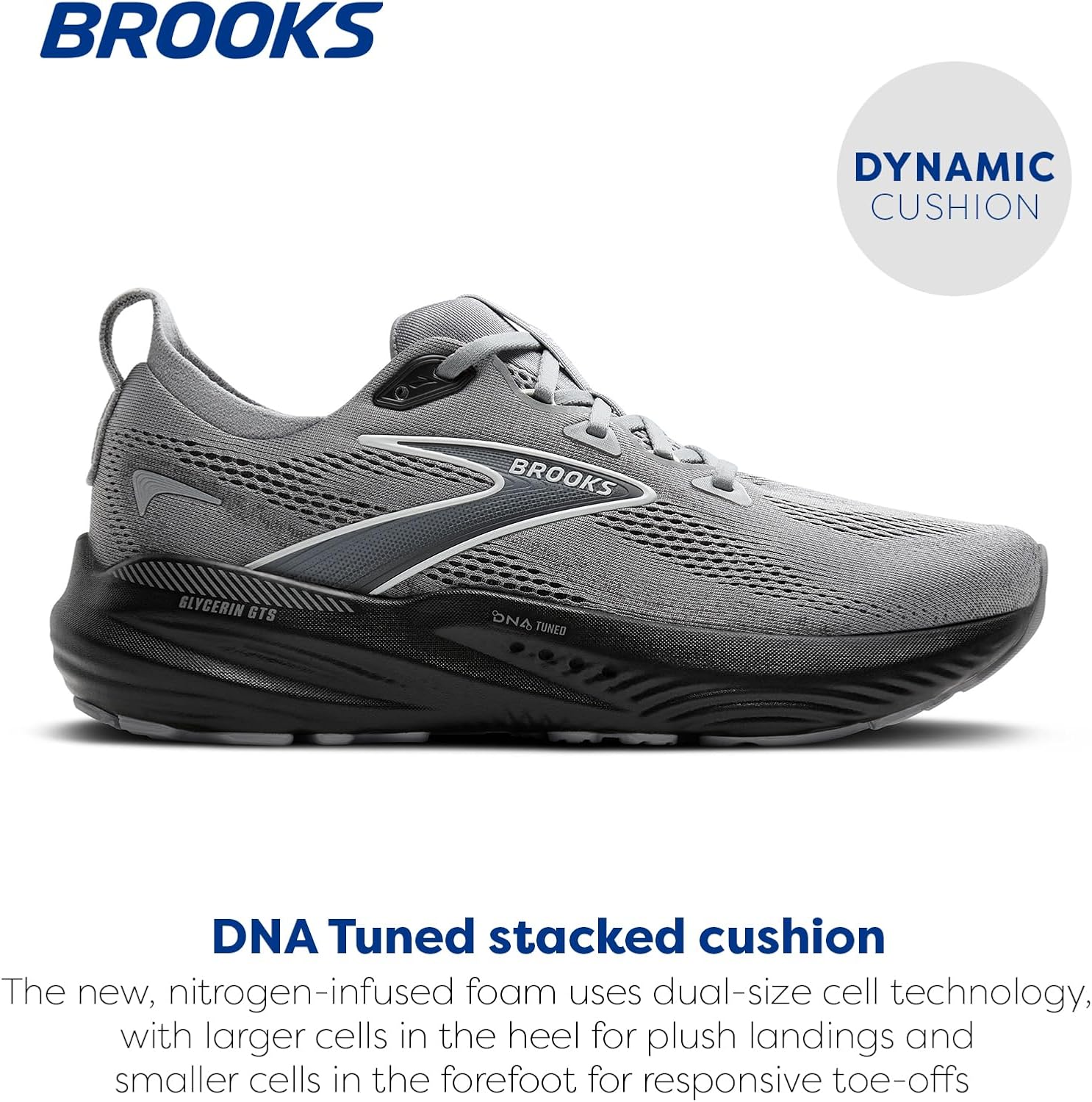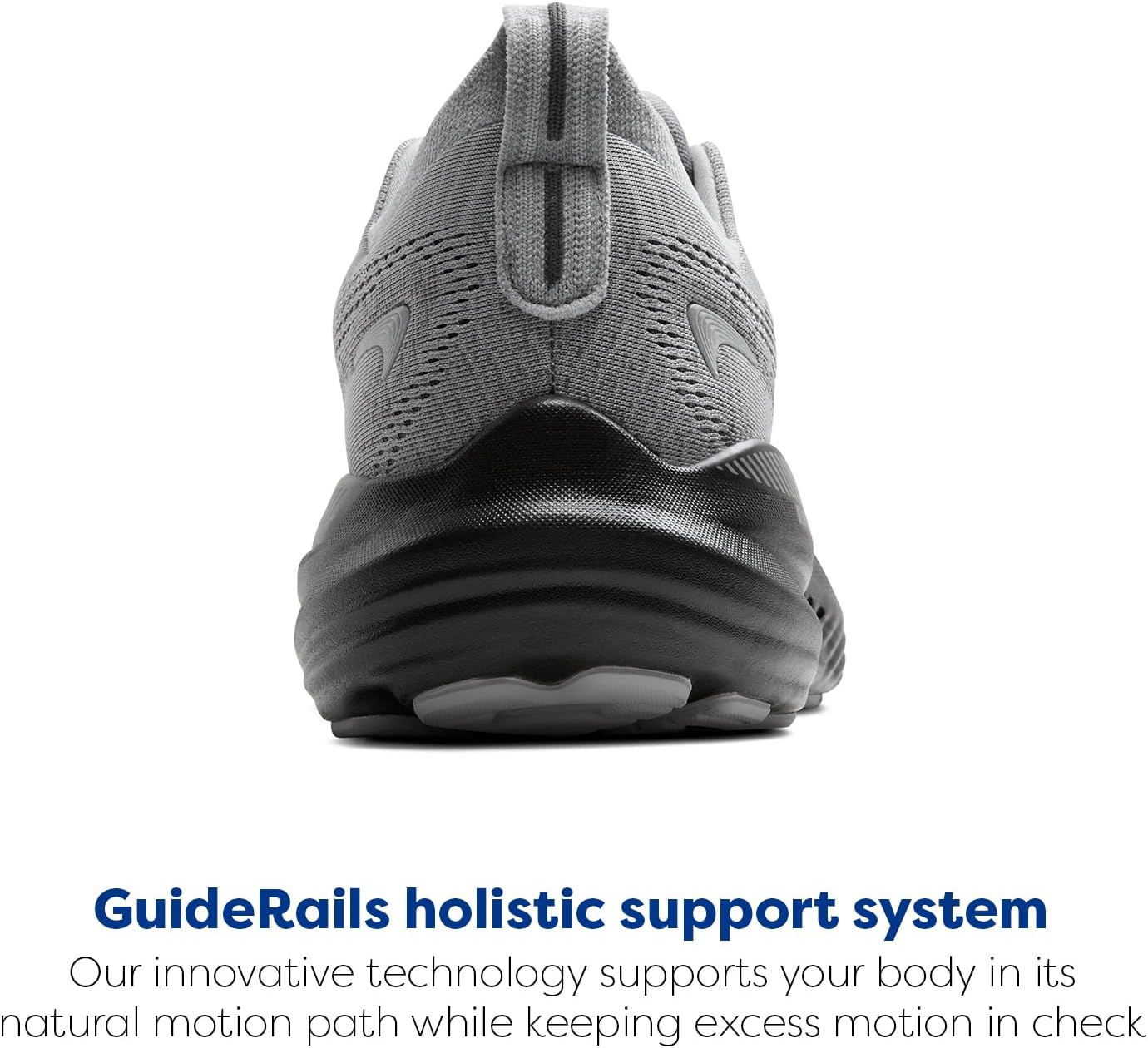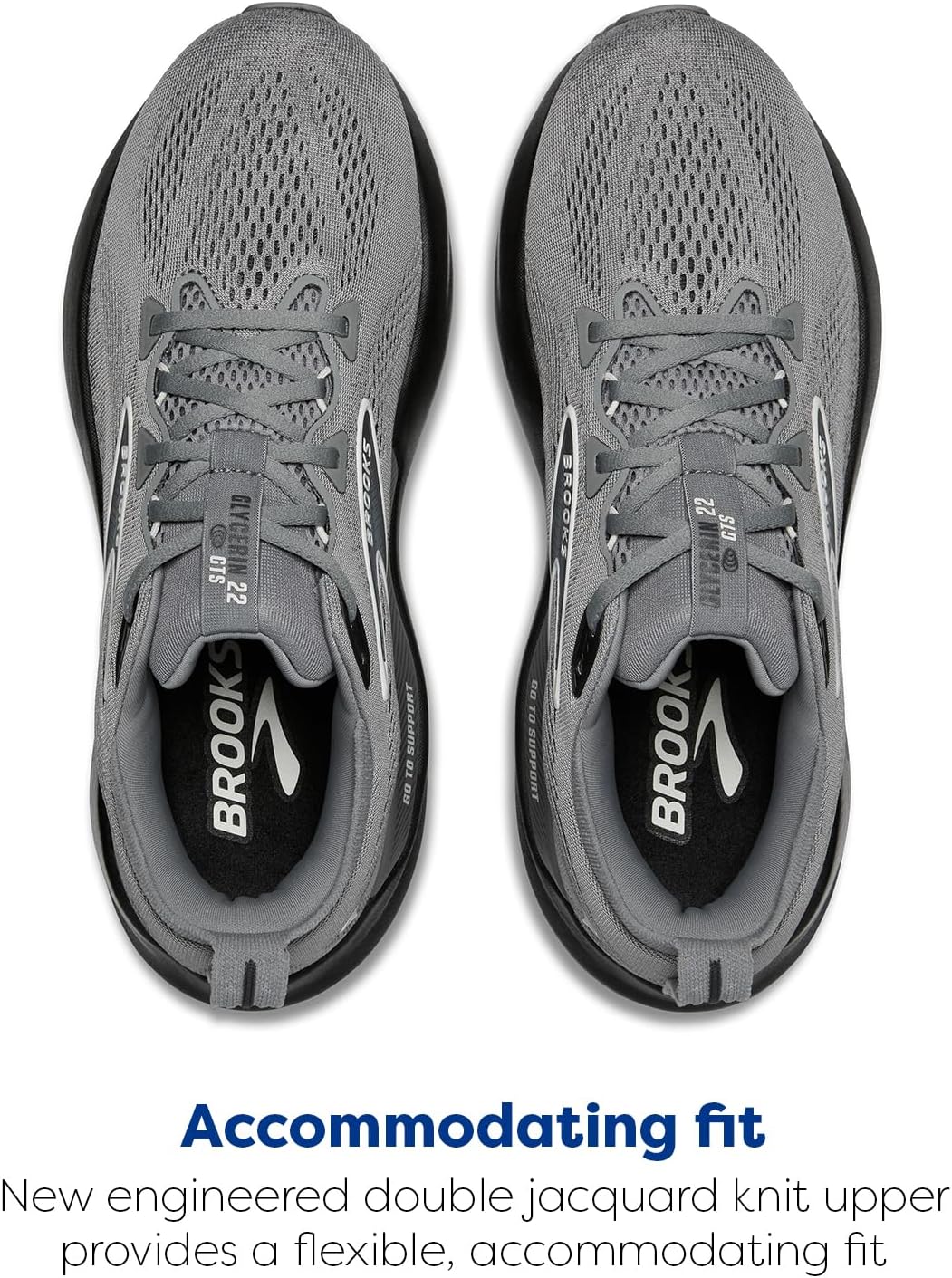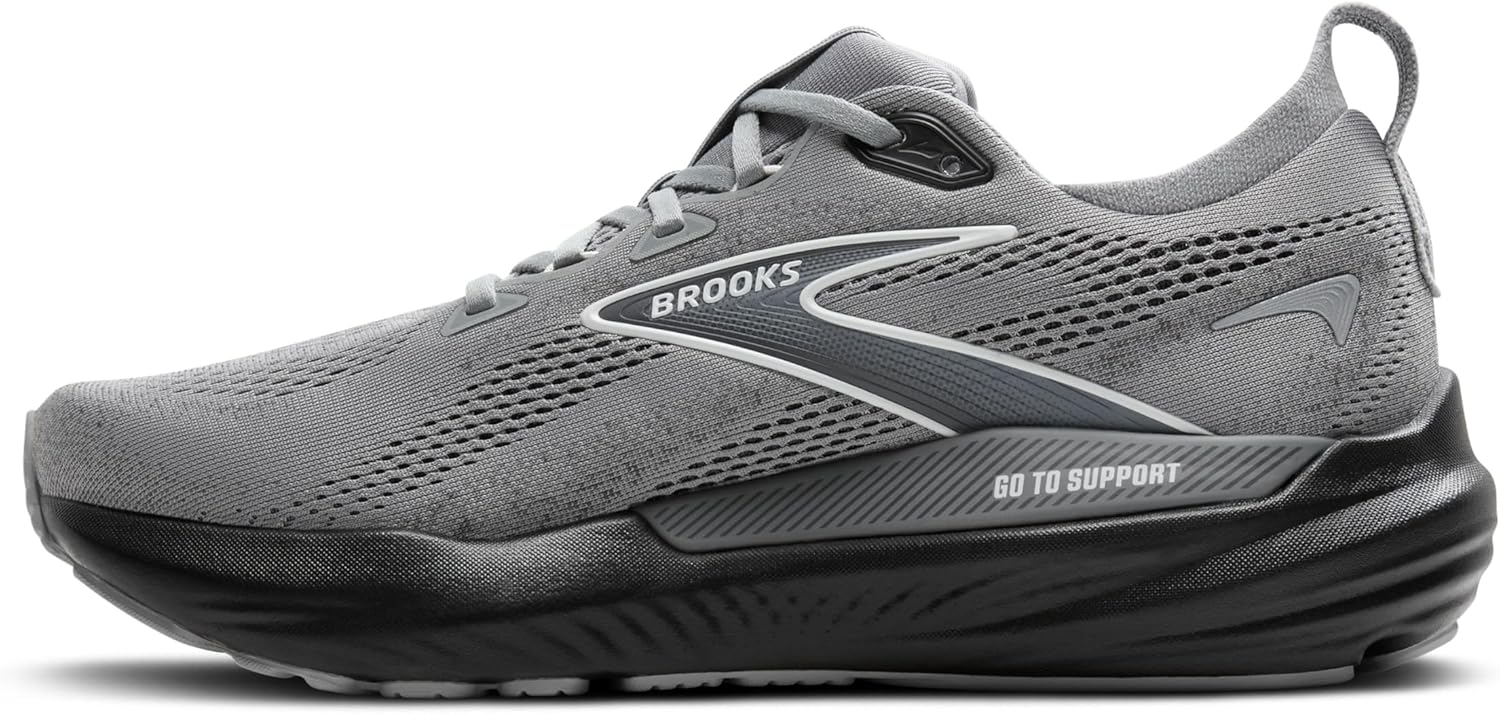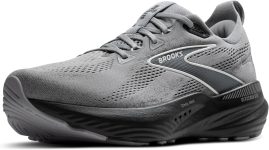
Brooks Men’s Glycerin GTS 22 Supportive Review brooks gts Buying Guide – Oemiu
Brooks Men’s Glycerin GTS 22: Your Guide to Supportive Running
The Brooks Glycerin series has long been a favorite amongst runners seeking premium cushioning and a plush ride. Now, the Glycerin GTS 22 continues that legacy, adding innovative support features to cater to those who need a little extra stability. The “GTS” stands for “Go-To Stability,” indicating that this shoe provides guidance and support without feeling overly rigid or intrusive. In this comprehensive review, we’ll dive deep into the Glycerin GTS 22, exploring its features, benefits, and how it stacks up against other stability running shoes. We’ll cover everything from the midsole technology to the outsole grip, helping you decide if this shoe is the right fit for your running needs.
Understanding the Brooks Glycerin GTS 22 and its Key Features
The Brooks Glycerin GTS 22 isn’t just a cushioned shoe; it’s a stability shoe designed to guide your foot through its natural gait cycle. At its core, the shoe incorporates Brooks’ GuideRails technology, which is crucial for preventing excess movement and promoting a smoother, more efficient stride. Unlike traditional stability shoes that rely on medial posts (firm foam inserts on the inside of the shoe), GuideRails are designed to only engage when needed, offering support without forcing your foot into a specific position. This dynamic support system is a game-changer for runners who experience overpronation, where the foot rolls inward excessively during the gait cycle. The Glycerin GTS 22 allows for a more natural running experience, minimizing the risk of discomfort or injury associated with forced correction.
Beyond the GuideRails, the shoe boasts a DNA LOFT v3 midsole, infused with nitrogen for an exceptionally soft and responsive feel. This cushioning system offers a luxurious experience underfoot, absorbing impact and providing energy return to propel you forward. The engineered mesh upper further enhances comfort, conforming to the shape of your foot for a secure and breathable fit. The upper’s design also incorporates strategic stretch and structure, allowing for natural foot movement while maintaining support where it’s needed most. Durability is also a key consideration, and the Glycerin GTS 22 features a durable rubber outsole that provides reliable traction on various surfaces. Whether you’re logging miles on the road, tackling a treadmill session, or hitting the park trails, the outsole is designed to withstand wear and tear, ensuring the shoe’s longevity. The Glycerin GTS 22 is a versatile shoe suitable for daily training, long runs, and even recovery days, making it a solid investment for runners of all levels.
Think of the GuideRails as bumpers on a bowling alley. They’re there to gently nudge you back on course if you start to veer too far to the side. This intelligent design allows your foot to move naturally within a healthy range of motion, intervening only when necessary to prevent excessive pronation or supination (outward rolling). This contrasts sharply with older stability shoe designs that often felt stiff and intrusive, forcing the foot into a rigid position. The result is a more comfortable and natural running experience, reducing the risk of blisters, hot spots, and other common running ailments. The balance between cushioning and support is truly where the Glycerin GTS 22 shines, offering a plush ride without sacrificing the stability features needed to maintain proper form and prevent injuries. For runners seeking a blend of comfort, support, and durability, the Brooks Glycerin GTS 22 is a top contender. It caters specifically to those requiring some level of stability, offering a supportive running experience without compromising on comfort or performance, making it a great choice for daily mileage and long runs alike.
Who Should Consider the Brooks Glycerin GTS 22?
Determining if the Brooks Glycerin GTS 22 is the right shoe for you depends largely on your individual running style and needs. If you experience mild to moderate overpronation, this shoe is definitely worth considering. Overpronation occurs when your foot rolls inward excessively after landing, which can lead to various issues such as ankle pain, knee pain, and even hip discomfort. The GuideRails technology in the Glycerin GTS 22 provides gentle guidance to correct this inward roll, helping to align your foot and ankle and reduce the risk of injury. However, even if you don’t have significant pronation, but still appreciate a touch of stability, the Glycerin GTS 22 can be a good option. Its dynamic support system adapts to your individual gait, providing support only when and where it’s needed. This makes it suitable for runners who may experience fatigue towards the end of a long run, when their form tends to break down and pronation may become more pronounced. The shoe’s generous cushioning also makes it an excellent choice for runners who prioritize comfort and impact absorption, especially during high-mileage training.
The Glycerin GTS 22 is also a great option for heavier runners who need extra support and cushioning. The DNA LOFT v3 midsole offers excellent shock absorption, protecting your joints from the impact of each stride. The durable outsole can withstand the wear and tear of higher mileage, providing reliable traction and support throughout your runs. Runners who appreciate a plush and comfortable fit will also appreciate the Glycerin GTS 22’s engineered mesh upper, which conforms to the shape of your foot for a secure and breathable feel. This upper design minimizes the risk of blisters and hot spots, ensuring a comfortable running experience even during long distances. On the other hand, if you are a neutral runner who does not require any stability features, or if you prefer a minimalist shoe with a low profile and firm ride, the Glycerin GTS 22 may not be the best choice for you. In such cases, you might consider the standard Brooks Glycerin 22, which offers similar cushioning without the GuideRails support. However, for runners seeking a blend of cushioning and support, the Glycerin GTS 22 is an excellent option to mitigate overpronation and maintain a more efficient running style.
Ultimately, the best way to determine if the Glycerin GTS 22 is right for you is to try it on and run in it. Visit a local running store where you can have your gait analyzed and receive personalized recommendations from experienced staff. They can assess your foot type, running style, and pronation levels to help you determine if the Glycerin GTS 22 or another shoe is the best fit for your needs. Consider your typical running distances, surfaces, and training goals when making your decision. If you primarily run on hard surfaces like asphalt or concrete, the Glycerin GTS 22’s cushioning will be particularly beneficial. If you’re training for a marathon or half-marathon, the shoe’s support and comfort can help you stay injury-free throughout your training program. Remember, finding the right running shoe is a highly personal process, and what works for one runner may not work for another. So, take the time to research, try on different options, and listen to your body to find the perfect shoe for your unique running needs. The brooks gts 22 for men provides a stable and comfortable ride.
Comparing the Brooks Glycerin GTS 22 to Other Stability Shoes
The running shoe market is filled with stability options, each with unique features and benefits. Comparing the Brooks Glycerin GTS 22 to other popular stability shoes can help you make an informed decision about which one is right for you. One of its main competitors is the Saucony Guide, another well-regarded stability shoe that offers a blend of cushioning and support. While both shoes utilize guide systems to correct overpronation, the Saucony Guide often features a slightly firmer ride compared to the Glycerin GTS 22’s plush cushioning. The Guide uses Saucony’s PWRRUN foam, which provides a responsive feel, while the Glycerin GTS 22 boasts the softer DNA LOFT v3. This difference in cushioning can be a deciding factor for runners who prefer a softer or firmer feel underfoot.
Another popular stability shoe is the ASICS GT-2000 series. ASICS shoes are known for their Gel cushioning system, which provides excellent shock absorption. The GT-2000 offers a more traditional stability design with a medial post, which provides a firmer level of support compared to the Glycerin GTS 22’s GuideRails. Some runners prefer the more pronounced support of a medial post, while others find it too intrusive. The Brooks Adrenaline GTS is another shoe to consider within the Brooks lineup. The Adrenaline GTS is a long-standing stability shoe that offers a more structured feel compared to the Glycerin GTS 22. While both shoes feature GuideRails technology, the Adrenaline GTS tends to have a slightly firmer ride and a more supportive upper. This can be beneficial for runners who need a higher level of stability or who prefer a more secure fit. Consider the New Balance Fresh Foam Vongo v6 as well. This shoe offers a unique approach to stability, utilizing a full-length midsole that provides inherent stability without relying on traditional posts or guide systems. The Vongo v6 offers a smoother and more natural ride compared to some of the other stability options, making it a good choice for runners who prefer a less intrusive form of support. Deciding between these shoes often comes down to personal preference and the specific level of support and cushioning you require. Think about how your gait feels in each shoe, and consider how the support impacts your overall comfort and running experience. Ultimately, the best stability shoe is the one that feels the most natural and comfortable for your individual running style.
To further illustrate the differences, here’s a comparison table:
| Feature | Brooks Glycerin GTS 22 | Saucony Guide | ASICS GT-2000 | Brooks Adrenaline GTS | New Balance Fresh Foam Vongo v6 |
|---|---|---|---|---|---|
| Stability Feature | GuideRails | TPU Guidance Frame | Medial Post | GuideRails | Full-Length Stability Midsole |
| Midsole Cushioning | DNA LOFT v3 (Nitrogen-Infused) | PWRRUN | FlyteFoam | DNA LOFT | Fresh Foam X |
| Cushioning Feel | Plush and Soft | Responsive and Balanced | Balanced | Balanced, Slightly Firmer | Smooth and Balanced |
| Support Level | Dynamic and Gentle | Moderate | Moderate to High | Moderate to High | Moderate |
| Best For | Daily Training, Long Runs | Daily Training, Moderate Pronation | Moderate to High Pronation | Daily Training, Higher Support Needs | Natural Stability, Moderate Pronation |
When comparing the Brooks GTS models against each other, such as the Adrenaline and Glycerin, the Glycerin GTS often wins out for runners seeking the plushest experience.
Getting the Right Fit and Optimizing Performance
Even the best running shoe won’t perform optimally if it doesn’t fit properly. Finding the right size and fit is crucial for maximizing comfort, preventing injuries, and enhancing your overall running experience with the Brooks Glycerin GTS 22. Start by getting your feet measured at a running store. Foot size can change over time, so it’s important to have an accurate measurement before purchasing new shoes. When trying on the Glycerin GTS 22, wear the socks you typically run in. This will ensure that you get a realistic fit. There should be about a thumb’s width of space between the end of your longest toe and the end of the shoe. This allows for natural foot expansion during running. Pay attention to the width of the shoe as well. If you have wide feet, consider opting for a wider width version of the Glycerin GTS 22. A shoe that’s too narrow can cause blisters and discomfort, while a shoe that’s too wide can lead to slippage and instability.
Once you have the right size, assess the overall fit and feel of the shoe. The upper should feel snug and secure, without being too tight or restrictive. There should be no pressure points or areas of discomfort. Walk around in the shoes for a few minutes to get a sense of how they feel on your feet. If possible, try them on a treadmill or run a few strides outside to see how they perform in motion. Pay attention to how your foot feels during the gait cycle. The GuideRails should provide gentle support without feeling intrusive or forcing your foot into a specific position. The cushioning should feel plush and responsive, absorbing impact and providing energy return. Proper lacing techniques can also play a significant role in optimizing the fit and performance of the Glycerin GTS 22. Experiment with different lacing patterns to find what works best for you. For example, if you have high arches, you might try a parallel lacing pattern to relieve pressure on the top of your foot. If you experience heel slippage, you can use a runner’s loop (also known as a heel lock) to secure your heel in place. Furthermore, consider using aftermarket insoles to customize the fit and feel of the Glycerin GTS 22. While the shoe’s standard insole provides adequate cushioning and support, some runners may prefer a more specialized insole to address specific needs, such as arch support or shock absorption. Finally, regularly inspect your Glycerin GTS 22 for signs of wear and tear. Replace your shoes every 300-500 miles, or sooner if you notice significant wear on the outsole or a decrease in cushioning. Proper care and maintenance will help to extend the life of your shoes and ensure that they continue to provide optimal performance and support.
The Brooks Men’s GTS 22: Weighing the Pros and Cons
Before making a final decision on the Brooks Glycerin GTS 22, it’s helpful to weigh the pros and cons to see if it aligns with your specific needs and preferences. On the pro side, the Glycerin GTS 22 offers exceptional cushioning thanks to its DNA LOFT v3 midsole, providing a plush and comfortable ride for runners of all levels. The GuideRails technology provides dynamic support to correct overpronation without feeling overly rigid or intrusive, making it a good choice for runners who need some stability without sacrificing comfort. The engineered mesh upper offers a secure and breathable fit, minimizing the risk of blisters and hot spots. The durable rubber outsole provides reliable traction on various surfaces, ensuring the shoe’s longevity. The Glycerin GTS 22 is a versatile shoe suitable for daily training, long runs, and even recovery days.
However, there are also some potential cons to consider. The Glycerin GTS 22 may not be the best choice for neutral runners who don’t need stability features, as the GuideRails could feel unnecessary or even restrictive. The shoe’s plush cushioning may feel too soft for some runners who prefer a firmer and more responsive ride. The Glycerin GTS 22 is also a relatively heavy shoe compared to some other running shoes, which could be a factor for runners who prioritize speed and efficiency. The price point of the Glycerin GTS 22 is also relatively high, which may be a barrier for some budget-conscious runners. The breathability, while generally good, may not be sufficient for runners who live in extremely hot and humid climates. Overall, the Brooks Glycerin GTS 22 is a top-performing stability shoe that offers exceptional cushioning, support, and comfort. However, it’s important to consider your individual running needs and preferences before making a purchase. Weigh the pros and cons carefully to determine if this shoe is the right fit for you.
Here’s a summary of the pros and cons:
- Pros:
- Exceptional cushioning
- Dynamic support with GuideRails
- Secure and breathable upper
- Durable outsole
- Versatile for various types of runs
- Cons:
- Not ideal for neutral runners
- Cushioning may be too soft for some
- Relatively heavy
- Higher price point
- Breathability may be limited in extreme heat
Conclusion: Is the Brooks Glycerin GTS 22 Right for You?
The Brooks Glycerin GTS 22 represents a compelling option for runners seeking a blend of plush cushioning and dynamic stability. Its key innovation, the GuideRails technology, delivers support in a non-intrusive manner, adapting to your individual gait and preventing excessive pronation without forcing your foot into a rigid position. The DNA LOFT v3 midsole provides a luxurious underfoot feel, making it a comfortable choice for daily training, long runs, and recovery days. The shoe’s durable outsole and secure upper further enhance its value, ensuring both longevity and a comfortable fit. The Glycerin GTS 22 stands out as a solid choice for runners who experience mild to moderate overpronation or those who appreciate a touch of stability, especially during longer runs when fatigue can compromise form. However, it’s crucial to consider your individual needs and preferences before making a purchase. Neutral runners may find the GuideRails unnecessary, while those who prefer a firmer ride might find the cushioning too soft. The shoe’s weight could also be a factor for runners prioritizing speed. If you prioritize cushioning, dynamic support, and a comfortable fit, and you don’t mind a slightly heavier shoe, the Brooks Glycerin GTS 22 is definitely worth considering. Visiting a running store for a gait analysis and a personalized shoe fitting is highly recommended to ensure that the Glycerin GTS 22 or any other shoe is the best fit for your unique needs. Ultimately, the right running shoe is the one that feels the most comfortable and supportive for your individual running style, helping you to stay injury-free and enjoy your runs to the fullest.
Frequently Asked Questions (FAQ)
What is the difference between the Brooks Glycerin 22 and the Brooks Glycerin GTS 22?
The primary difference between the Brooks Glycerin 22 and the Brooks Glycerin GTS 22 lies in their level of stability. The Glycerin 22 is a neutral running shoe, designed for runners who have a neutral gait and don’t require any additional support to correct overpronation. It focuses purely on providing a cushioned and comfortable ride. On the other hand, the Glycerin GTS 22 (GTS stands for “Go-To Stability”) is a stability shoe designed for runners who experience mild to moderate overpronation. It features Brooks’ GuideRails technology, which provides dynamic support to help correct the inward rolling of the foot during the gait cycle. These GuideRails act like bumpers, gently guiding the foot back into alignment only when needed, without forcing it into a rigid position. Essentially, the Glycerin GTS 22 takes the plush cushioning of the Glycerin 22 and adds a stability component for runners who require it. If you have a neutral gait, the Glycerin 22 is the better choice. If you overpronate, the Glycerin GTS 22 is the more appropriate option.
How does the GuideRails technology in the Brooks Glycerin GTS 22 work?
Brooks’ GuideRails technology is designed to provide dynamic support, meaning it only engages when needed to prevent excess movement and guide the foot back into alignment. Unlike traditional stability shoes that use medial posts (firm foam inserts) to force the foot into a specific position, GuideRails are more subtle and responsive. They work by positioning supportive elements on either side of the foot to minimize excess heel and shin rotation. If your foot is moving within a healthy range of motion, the GuideRails remain passive and do not interfere with your natural gait. However, if your foot starts to roll inward excessively (overpronation) or outward (supination), the GuideRails kick in to gently nudge it back into a more neutral position. This prevents the foot from exceeding its natural range of motion, reducing the risk of injury and improving running efficiency. The design allows for a more natural running experience. GuideRails promote a smoother stride while providing the necessary support when needed, offering a significant improvement over traditional stability mechanisms that can feel stiff and restrictive.
Is the Brooks Glycerin GTS 22 suitable for long-distance running?
Yes, the Brooks Glycerin GTS 22 is well-suited for long-distance running. Several features make it a great choice for racking up the miles. First and foremost, the DNA LOFT v3 midsole provides exceptional cushioning and shock absorption, which is crucial for protecting your joints during long runs. The plush cushioning helps to minimize impact fatigue, allowing you to stay comfortable and maintain your form even after many miles. Secondly, the GuideRails technology offers dynamic support to prevent overpronation, which can become more pronounced as fatigue sets in during long runs. By providing gentle guidance and preventing excess movement, the GuideRails help to maintain proper alignment and reduce the risk of injuries. The Glycerin GTS 22’s secure and breathable upper also contributes to its suitability for long distances, minimizing the risk of blisters and hot spots. Finally, the durable outsole provides reliable traction on various surfaces, ensuring that you can confidently tackle long runs on roads, trails, or treadmills. The combination of cushioning, support, and durability makes the Glycerin GTS 22 an excellent option for runners preparing for marathons, half-marathons, or any other long-distance event.
How often should I replace my Brooks Glycerin GTS 22 running shoes?
The lifespan of running shoes, including the Brooks Glycerin GTS 22, depends on several factors, including your running mileage, running surface, and individual running style. As a general guideline, you should aim to replace your running shoes every 300 to 500 miles. However, this is just an estimate, and you may need to replace them sooner or later depending on your specific circumstances. The best way to determine if it’s time to replace your Glycerin GTS 22 is to pay attention to how they feel and look. Look for signs of wear and tear, such as excessive wear on the outsole, compression of the midsole, or a decrease in cushioning. If your shoes no longer feel as comfortable or supportive as they used to, it’s likely time for a new pair. Some runners also find that they start experiencing aches and pains or increased fatigue when their shoes are worn out. Another factor to consider is the running surface. Running on hard surfaces like asphalt or concrete will typically wear down your shoes faster than running on softer surfaces like trails or grass. Your running style can also affect the lifespan of your shoes. If you are a heavier runner or tend to strike the ground harder, your shoes may wear out more quickly. Regularly inspecting your shoes and paying attention to how they feel is the best way to determine when it’s time for a replacement, ensuring optimal performance and injury prevention.
Can I use the Brooks Glycerin GTS 22 for walking?
Yes, you can absolutely use the Brooks Glycerin GTS 22 for walking. While designed primarily for running, its features also make it a comfortable and supportive choice for walking. The DNA LOFT v3 midsole provides excellent cushioning, which is beneficial for reducing impact and fatigue during long walks. The GuideRails technology can help to improve alignment and prevent overpronation, which can be especially helpful if you tend to roll your ankles inward while walking. The secure and breathable upper ensures a comfortable fit, minimizing the risk of blisters and hot spots. The durable outsole provides reliable traction on various surfaces, making it suitable for walking on roads, sidewalks, or even light trails. Individuals with flat feet, overpronation, or plantar fasciitis may find that the Glycerin GTS 22 provides the necessary support and cushioning for comfortable walking. However, it’s important to note that some walkers may prefer a shoe with a firmer ride or a lower profile, in which case the Glycerin GTS 22 might feel too soft or bulky. Ultimately, the best way to determine if the Glycerin GTS 22 is right for your walking needs is to try it on and walk around in it to see how it feels. If you prioritize cushioning, support, and a comfortable fit, the Glycerin GTS 22 can be a great option for your daily walks.
Are there different versions of the Brooks Glycerin GTS 22 for different foot types?
While there aren’t fundamentally different versions of the Brooks Glycerin GTS 22 designed specifically for different foot types, Brooks offers the shoe in various widths to accommodate different foot shapes. The standard version of the Glycerin GTS 22 is designed for runners with a medium-width foot. However, Brooks also offers the shoe in wide and extra-wide widths to accommodate runners with wider feet. Choosing the correct width is crucial for ensuring a comfortable and secure fit. A shoe that is too narrow can cause blisters and discomfort, while a shoe that is too wide can lead to slippage and instability. If you’re unsure about your foot width, it’s best to have your feet measured at a running store. In addition to width options, some retailers may offer special editions or colorways of the Glycerin GTS 22, but these typically do not involve any changes to the shoe’s core features or design. Ultimately, the key to finding the right fit for your foot type is to try on the shoe in different widths and see which one feels the most comfortable and secure. If you have any specific foot conditions, such as flat feet or high arches, you may also want to consider using aftermarket insoles to provide additional support and cushioning.
Where can I buy the Brooks Glycerin GTS 22?
The Brooks Glycerin GTS 22 is widely available for purchase through various channels, both online and in brick-and-mortar stores. The most obvious place to start your search is on the official Brooks Running website, where you can find the latest models, colors, and sizes. Buying directly from Brooks often provides access to exclusive promotions and discounts. Many specialty running stores also carry the Glycerin GTS 22. These stores often have knowledgeable staff who can provide personalized recommendations and help you find the right fit. They may also offer gait analysis services to help you determine if the Glycerin GTS 22 is the right shoe for your running style. Major sporting goods retailers, such as Dick’s Sporting Goods and REI, also typically carry the Glycerin GTS 22. These stores offer a wide selection of running shoes and apparel, making it a convenient one-stop shop for all your running needs. Online marketplaces like Seller and Zappos are also popular options for buying the Glycerin GTS 22. These sites often offer competitive prices and a wide range of sizes and colors. However, it’s important to ensure that you are purchasing from a reputable seller to avoid counterfeit or damaged products. Finally, consider checking outlet stores or discount retailers for potential deals on the Glycerin GTS 22. Clearance sales and seasonal promotions can offer significant savings. Comparing prices across different retailers before making a purchase is always a good idea to ensure that you’re getting the best possible deal.
